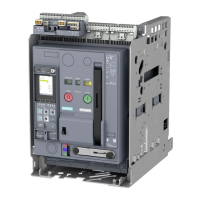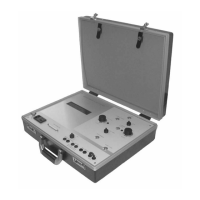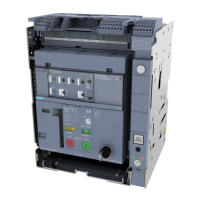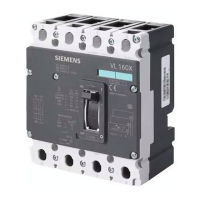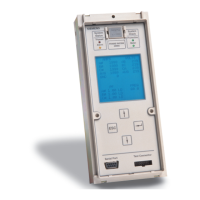9 – 26
Charakterystyka wyzwalania jest krzywą I
2
t. Niektóre moduły
przetężeniowe mogą być przełączone i wyzwalane dla krzywej I
4
t.
(strona 9-30)
Wyzwalanie zwarciowe z krótką zwłoką – wyzwalanie S
W modułach przetężeniowych ETU25B … ETU76B wyzwolenie
spowodowane prądem zwarciowym I
sd
może zostać opóźnione
o czas t
sd
.
Pozwala to na uzyskanie selektywności zabezpieczenia
zwarciowego w instalacjach przełączających poprzez stopniowanie
czasu zadziałania.
1)
Czas opóźnienia 0,02 s nie jest czasem stopniowania!
W tym położeniu zostaje uruchomiona funkcja ochrony napędu.
2)
Dla ustawień tsd < 0,4 s następuje automatyczna redukcja maksymalnej,
możliwej do ustawienia wartości Isd, w zależności od wielkości wyłącznika:
Wyłącznik rozmiaru I : 15 kA
Wyłącznik rozmiaru II : 20 kA
Wyłącznik rozmiaru III : 30 kA
Dla ustawienia czasu tsd = 0, moduły przetężeniowe ETU25B ...
27B mogą realizować funkcję bezzwłocznej ochrony zwarciowej,
z regulowaną wartością progową, która będzie mniejsza od stałej
wartości prądu I
i
.
Pozycja „OFF” w modułach przetężeniowych ETU45B ... 76B
pozwala wyłączyć zabezpieczenie zwarciowe z krótką zwłoką
czasową.
Jeśli zostanie wykorzystana funkcja strefowego, selektywnego
sterowania (ZSI) (strona 9-30), to wtedy zostanie zignorowane
ustawienie czasu opóźnienia t
sd.
Jeśli wyłącznik nie otrzyma
żadnego sygnału zablokowania ze znajdującego się za nim
(downstream) wyłącznika, wtedy zostanie on wyzwolony po 50 ms,
niezależnie od ustawienia czasu t
sd
.
Niektóre moduły przetężeniowe mogą być przełączane i wyzwalane
dla krzywej I
2
t. (strona 9-31)
Funkcja ochrony napędu
W położeniu wyłącznika t
sd
= (0,02 s) włączona jest specjalna
funkcja zabezpieczająca dla napędów elektrycznych, która
uniemożliwia wyzwolenie ochrony zwarciowej z krótką zwłoką
czasową, spowodowane przez skok wartości prądu w trakcie
uruchomienia silnika. Równocześnie, uruchomione zostaje
zabezpieczenie zaniku fazy (strona 9-29) oraz przełączenie
stałej czasowej dla wewnętrznych obliczeń procesu wzrostu
temperatury oraz procesu chłodzenia, z wartości dla ochrony
układów przełączających, na wartość dla funkcji ochrony napędów.
Bezzwłoczne wyzwalanie zwarciowe – wyzwalanie I
Przekroczenie ustawionej wartości progowej prądu I
i
prowadzi do
bezzwłocznego wyzwolenia wyłącznika.
Ustawienia prądu I
sd
ETU25B … 45B I
sd
= (1,25/1,5/2/2,5/3/4/6/8/10/12) x I
n
ETU55B … 76B
I
sd
= 1,25 x I
n
…
0,8 x I
CW
(dane w amperach)
Ustawienia czasu t
sd
ETU25B … 27B
t
sd
= 0/0,02(M)
1)
/0,1/0,2/0,3/0,4 s
ETU45B
t
sd
= 0,02(M)
1)
/0,1/0,2/0,3/0,4 s;
OFF (wyłączenie)
ETU55B … 76B
t
sd
= 0,02(M)
1)
/0,08 … 4 s
2)
;
OFF (wyłączenie)
M
The tripping characteristic is an I
2
t-characteristic. Some overcurrent
releases can be switched over to an I
4
t-characteristic.
(page 9-30)
Short-time-delay short-circuit tripping – S-tripping
On overcurrent releases ETU25B ... 76B, tripping due to the short-
circuit current I
sd
can be delayed by the time t
sd
.
This provides selectivity for the short-circuit protection in switchgear
with several grading levels.
1)
The time delay 0.02 s isn't a grading time!
In this position, the motor protection function is activated.
2)
For settings t
sd
>0.4 s, the maximum possible setting I
sd
is reduced
automatically according to the frame size:
Frame size I : 15 kA
Frame size II : 20 kA
Frame size III : 30 kA
With the setting t
sd
= 0 s, the overcurrent releases ETU25B ... 27B
can provide an instantaneous short-circuit protection with an adjust-
able operate value which is smaller than the fixed operate value I
i
.
The setting "OFF" for the overcurrent releases ETU45B ... 76B is
provided to deactivate the short-time-delay short-circuit protection.
If the zone selective interlocking (ZSI) (page 9-30) is used, how-
ever, the setting for the time delay t
sd
is deactivated. If the circuit-
breaker does not receive any blocking signal from a downstream cir-
cuit-breaker, it will trip after 50 ms regardless of the setting for t
sd
.
Some overcurrent releases can be switched over to an I
2
t-
characteristic. (page 9-31)
Motor protection function
In the circuit-breaker position t
sd
= (0.02 s), a special protection
function for electromotive drives is activated. It prevents the short-
time-delay short-circuit tripping from being activated during the
peak inrush current of electric motors. At the same time, a phase
failure protection is activated (page 9-29) and the time constant
for the internally calculated reproduction of the temperature-rise and
cooling process is switched over from switchgear protection to
motor protection.
Instantaneous short-circuit tripping – I-tripping
If the current setting I
i
is exceeded, the circuit-breaker is tripped
instantaneously.
Current settings for I
sd
ETU25B … 45B I
sd
= (1.25/1.5/2/2.5/3/4/6/8/10/12) x I
n
ETU55B … 76B
I
sd
= 1.25 x I
n
…
0.8 x I
CW
(data in Amps)
Settings for t
sd
ETU25B … 27B t
sd
= 0/0.02(M)
1)
/0.1/0.2/0.3/0.4 s
ETU45B t
sd
= 0.02(M)
1)
/0.1/0.2/0.3/0.4 s; OFF
ETU55B … 76B t
sd
= 0.02(M)
1)
/0.08 … 4 s
2)
; OFF
M

